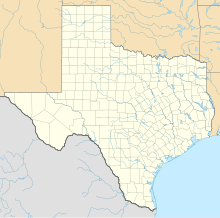Byzantine Fresco Chapel

The exterior of the Byzantine Fresco Chapel in Houston
|
|
| Established | September 1997, reopened 2015 |
|---|---|
| Dissolved | 2011 |
| Location | Houston, Texas, U.S. |
| Coordinates | 29°44′11″N 95°23′43″W / 29.7364°N 95.3953°W |
| Website | www |
The Byzantine Fresco Chapel is a part of the Menil Collection in Houston, Texas, near the University of St. Thomas. From February 1997 to February 2012, it displayed the only intact Byzantine frescoes of this size and importance in the entire western hemisphere. The Byzantine frescoes had been taken from the church of St. Evphemianos in Lysi, Cyprus in the 1980s. In September 2011, the collection announced that the frescos would be permanently returned to Cyprus in February 2012, following the conclusion of a long-term loan agreement with the Greek Orthodox Church of Cyprus.. The frescoes had been presented at the museum by agreement with the Church of Cyprus, their owners, but the church decided not to extend the loan further. They will not return to their original home as Lysi is now in Northern Cyprus, but will be displayed at the Byzantine Museum in Nicosia. On March 4, 2012, the Byzantine Fresco Chapel closed, but re-opened in 2015 for the first in a series of site-specific projects.
The chapel was opened in February 1997, and displayed masterworks from the 13th century—a dome with and an apse depicting the Virgin Mary the Panayia. The frescoes had been stolen from a chapel near Lysi in the Turkish-occupied section of Cyprus in the 1980s, cut into 38 pieces, and shipped to Germany by thieves to sell them in the arts black-market. The 38 fresco fragments were bought from the thieves by the Houston-based Menil Foundation on behalf of the Church of Cyprus, the rightful owner of the frescoes. The Menil Foundation then funded a careful restoration of the paintings. These intact frescoes were unique in the western hemisphere.
The major part of the collection consisted of the frescoes of the dome and apse. According to the guide to the museum, "the Lysi dome represents Christ Pantokrator, 'All sovereign'. It defines a space with no beginning and no end." The depiction of Christ gazing directly forward "has driven time out of space. His gaze is transworldly: not looking but all-seeing." By not depicting the Lord below the bust, he is "universal and ubiquitous." Surrounding the figure of Christ is a double row of angels moving towards the throne prepared by God the Father for the Second Coming of Christ. The throne is guarded by the Archangel Michael and Archangel Gabriel and two seraphim. The Virgin Mary leads one line of angels to the throne, while John the Baptist leads the other.
...
Wikipedia

